Category: Neurology
Keywords: Hydrocephalus, CSF shunt malfunction, ventriculomegaly, Evans' ratio (PubMed Search)
Posted: 10/8/2014 by WanTsu Wendy Chang, MD
Click here to contact WanTsu Wendy Chang, MD
Hydrocephalus is a disorder of cerebrospinal fluid (CSF) accumulation. Acute obstructive hydrocephalus such as in subarachnoid hemorrhage and CSF shunt malfunction can cause a rapid rise in intracranial pressure. Nonobstructive hydrocephalus is associated with subacute symptoms. Clinical features of acute obstructive hydrocephalus include headache, blurred vision, papilledema, ocular palsies, nausea and vomiting, and decreased level of consciousness.
Evaluation of hydrocephalus in the ED should include neuroimaging, typically noncontrast head CT given its wide availability. CT characteristics of hydrocephalus can be seen in Figure 1: ventriculomegaly with dilated 3rd ventricle, dilated 4th ventricle, and presence of temporal horns.
When evaluating patients with pre-existing hydrocephalus for worsening symptoms, such as in the evaluation of CSF shunt malfunctions, it is helpful to compare the head CT or MRI for interval ventricular enlargement. Two simple measurements can be taken on a CT or MRI for objective comparisons (Figure 2).
Evans' ratio = A/B = Maximum width of frontal horns (A) divided by maximum width of inner skull (B) at the same CT/MRI level
C = Width of 3rd ventricle
Use of acetazolamide to decrease CSF production is not effective in long-term treatment of hydrocephalus. About 75% of patients with hydrocephalus require CSF shunt placement.
Shprecher D, Schwalb J, Kurlan R. Normal pressure hydrocephalus: diagnosis and treatment. Curr Neurol Neurosci Rep. 2008;8(5):371-376.
Poca MA, Sahuquillo J. Short-term medical management of hydrocephalus. Expert Opin Pharmacother. 2005;6(9):1525-1538.
Anvekar B 2011, Neuroradiology Cases, viewed 8 October 2014,
Category: Misc
Keywords: app pearls apple google (PubMed Search)
Posted: 10/7/2014 by Kevin Hamilton
Click here to contact Kevin Hamilton
We are proud to announce the release of our new UMEM Pearls App, now available in the Apple App Store and the Google Play Marketplace! You will now be able to pull down pearl content for offline viewing, in addition to having all of the pearls in searchable format available on your mobile devices.
Click either of the following links on your mobile device to download your Pearls App today!
Category: Critical Care
Posted: 10/6/2014 by John Greenwood, MD
(Updated: 10/7/2014)
Click here to contact John Greenwood, MD
The ARISE Trial
Early, aggressive resuscitation and attention to detail are essential element of managing critically ill patients. This past week the ARISE trial was published - a 2nd large, randomized control study to examine the benefit of protocolized vs. usual care in patients with severe sepsis and septic shock.
What were the main findings? After enrolling 1,600 patients who presented to the ED in severe sepsis or septic shock:

Bottom Line: Resuscitation goals for the patient with septic shock should include:
Additional therapeutic goals should be made on a patient by patient basis. Reassess your patient frequently, pay attention to the details, and you will improve your patient’s mortality.
Suggested Reading
Follow Me on Twitter: @JohnGreenwoodMD
Category: Visual Diagnosis
Posted: 10/6/2014 by Haney Mallemat, MD
Click here to contact Haney Mallemat, MD
7d old child presents with difficulty feeding,vomiting one time, and now with intermittent apneic episodes. What's the diagnosis? (Careful....this one is tricky!)
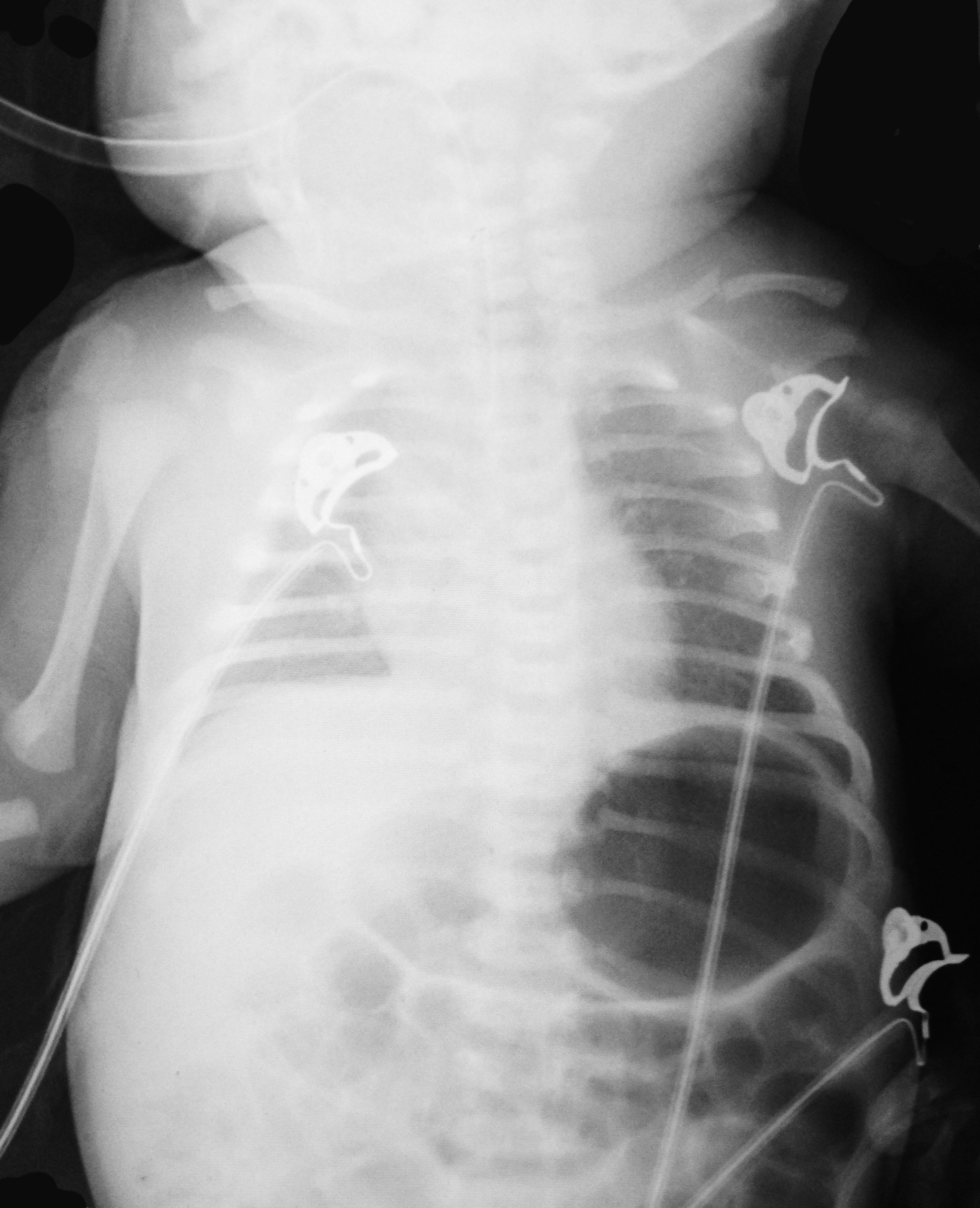
Answer: Workup should include an ALTE and sepsis evaluation PLUS evaluation for non-accidental trauma
Non-accidental trauma (NAT)
NAT is most prevalent in children 0-3 months of age.
Classic metaphyseal lesions, rib fractures, and fractures in various stages of healing are most commonly described in children.
How do we know this is not just birth trauma from a shoulder dystocia, large for gestational age, or difficult vaginal delivery?
Subperiosteal new bone formation appears as a:
NAT Work-up:
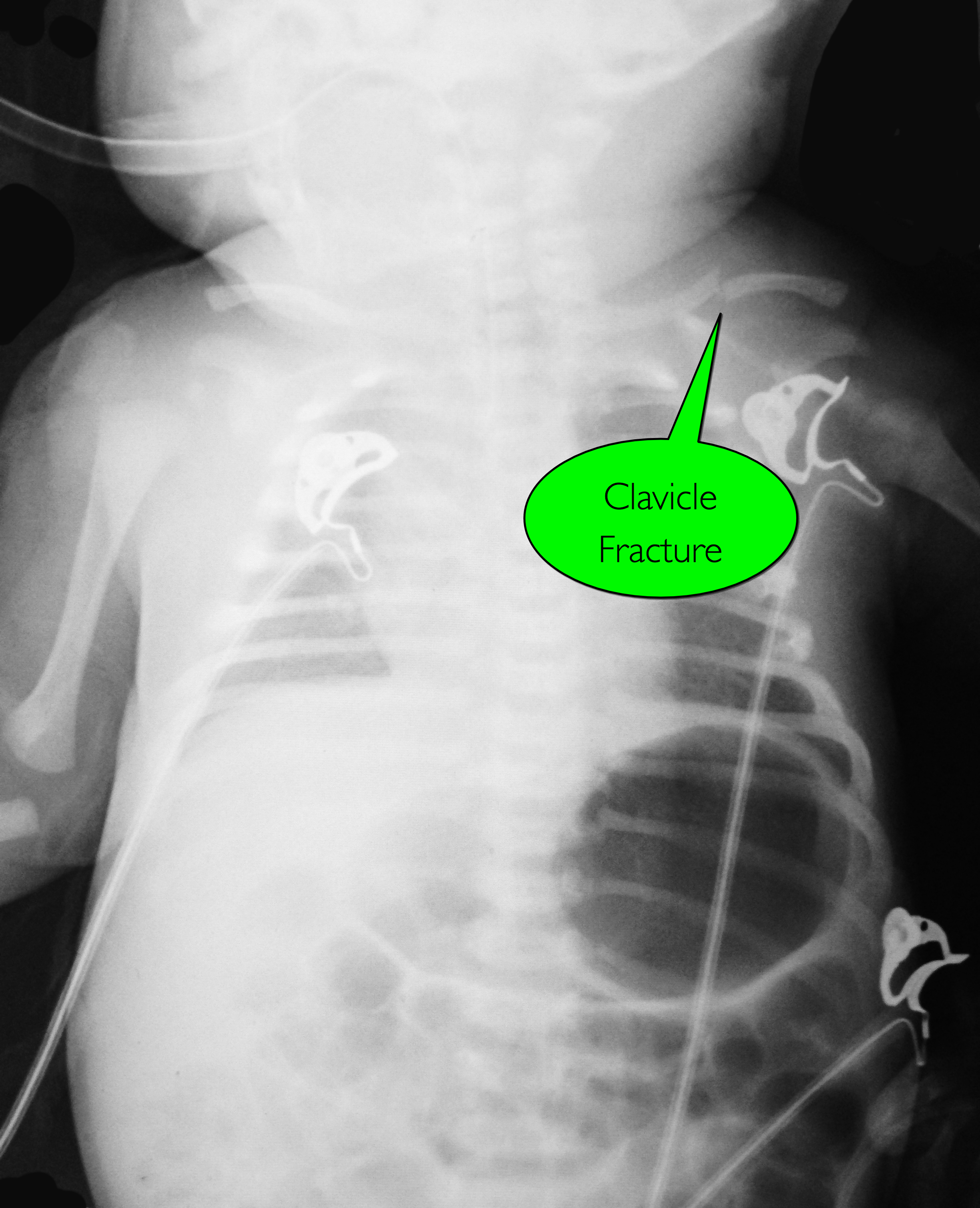
Follow me on Twitter (@criticalcarenow) or Google+ (+criticalcarenow)
Category: Cardiology
Posted: 10/4/2014 by Semhar Tewelde, MD
Click here to contact Semhar Tewelde, MD
Kounis Syndrome (Part I)
- Kounis & Zavras (1991) described the syndrome of allergic angina and allergic myocardial infarction, currently known as Kounis syndrome (KS). Braunwald (1998) noted vasospastic angina can be induced by allergic reactions, with mediators such as histamine and leukotrienes acting on coronary vascular smooth muscle.
- Two subtypes have been described: type I, occurring in patients without predisposing factors for CAD often caused by coronary artery spasm and type II, occurring with angiographic evidence of coronary disease when the allergic events induce plaque erosion or rupture.
- This syndrome has been reported in association with a variety of medical conditions, environmental exposures, and medication exposures. Entities such as Takotsubo cardiomyopathy, drug-eluted stent thrombosis, and coronary allograft vasculopathy also appear to be associated with this syndrome.
- Clinical presentation includes: symptoms and signs of an allergic reaction and acute coronary syndrome: chest pain, dyspnea, faintness, nausea, vomiting, syncope, pruritus, urticaria, diaphoresis, pallor, palpitations, hypotension, and bradycardia.
Kounis GN, Kounis SA, Hahalis G, et al. Coronary artery spasm associated with eosinophilia: another manifestation of Kounis syndrome? Heart Lung Circ 2009;18:163–164.
Mytas DZ, Stougiannos PN, Zairis MN, et al. Acute anterior myocardial infarction after multiple bee stings. A case of Kounis syndrome. Int J Cardiol 2009;134:e129–e131.
Category: Pharmacology & Therapeutics
Keywords: beta-lactam, piperacillin/tazobactam, critically ill (PubMed Search)
Posted: 9/27/2014 by Bryan Hayes, PharmD
(Updated: 10/4/2014)
Click here to contact Bryan Hayes, PharmD
Beta-lactam antimicrobials (penicillins, cephalosporins, and carbapenems) are frequently used for empiric and targeted therapy in critically ill patients. They display time-dependent killing, meaning the time the antibiotic concentration is above the minimin inhibitory concentration (MIC) is associated with improved efficacy.
Two new pharmacodynamic/pharmacokinetic studies suggest that current beta-lactam antimicrobial dosing regimens may be inadequate.
Antimicrobial dosing in critically ill patients is complex. Current dosing of beta-lactams may be inadequate and needs to be studied further with relation to clinical outcomes.
Follow me on Twitter (@PharmERToxGuy) or Google Plus (+bryanhayes13)
Category: International EM
Keywords: Influenza (PubMed Search)
Posted: 10/1/2014 by Jon Mark Hirshon, MPH, MD, PhD
(Updated: 10/29/2014)
Click here to contact Jon Mark Hirshon, MPH, MD, PhD
INFLUENZA
What is it?
Why do we care about influenza?
Bottom line
Category: Toxicology
Keywords: Digoxin, Cardioactive Steroids, Digitoxin, Digoxin-specific Fab Fragment (PubMed Search)
Posted: 10/1/2014 by Kishan Kapadia, DO
Click here to contact Kishan Kapadia, DO
Cardioactive steroids are among the many treatments used for CHF, and for the control of ventricular response rate in atrial tachydysrhythmias. There are many sources of cardioactive steroids:
Pharmaceutial: Digoxin, Digitoxin
Plants: Oleander, Yellow Oleander, Foxglove, Lily of the Valley, Dogbane, Red Squill
Animal: Bufo marinus toad
It is a potent Na+-K+-ATPase inhibitor and can lead to hyperkalemia in acute ingestion with associated signs and symptoms of N/V, abdominal pain, bradycardia and possibly, hypotension.
Toxicity should be suspected with bidirectional ventricular tachycardia or atrial tachycardia with high-degree AV block
Therapeutic range of digoxin of 0.5 - 2.0 ng/mL is helpful but not a sole indicator of toxicity
Indication for antidote (Digoxin-specific Antibody Fragments) include:
1) Digoxin-related life-threatening dysrhythma
2) Serum K+ > 5.0 mEq/L in acute ingestion
3) Serum digoxin concentration >15ng/mL at any time, or >10 ng/mL 6 hours postingestion
4) Ingestion of 10 mg in adult; 4 mg in pediatric
5) Poisoning by non-digoxin cardioactive steroid
Goldfrank's Toxicologic Emergencies, 9th edition
Category: Critical Care
Posted: 9/30/2014 by Haney Mallemat, MD
(Updated: 10/1/2014)
Click here to contact Haney Mallemat, MD
The last Back to the Basics post discussed the use of vasopressors to improve hemodynamics by increasing arterial (and venous) tone. This time we’ll discuss the use of agents to increase inotropy for patients with severe systolic dysfunction / failure.
Dobutamine: a direct b1 and b2-receptors agonist. It has no peripheral vasoconstrictor properties, so if blood pressure increases it occurs secondary to increased cardiac output. Unfortunately, blood pressure may be decreased in some patients due to its peripheral vasodilatory effects; in these cases it may need to be used with a vasopressor.
Milrinone: augments contractility by increasing intracellular Ca levels via cellular phosphodiesterase inhibition. Because it does not work on beta-receptors, it might be preferred for patients taking beta-blockers requiring inotropic support. It may cause peripheral vasodilation and hypotension, but this may be a benefit if pulmonary artery pressure is elevated as reductions in pulmonary artery pressure lead to improvements in right ventricular function. It has a long-half life and should be avoided in patients with renal impairment.
Dopamine: chemical precursor to norepinephrine and technically a vasopressor. At moderate doses (3-10 mcg/kg/min) it works on beta-receptors to increase myocyte contractility. At higher doses works primarily as a vasopressor, which may reduce cardiac output due to higher afterload.
Norepinephrine/epinephrine: has alpha and beta properties that lead to increased peripheral vasoconstriction, but also increases inotropy and chronotropy (faster heart rate)
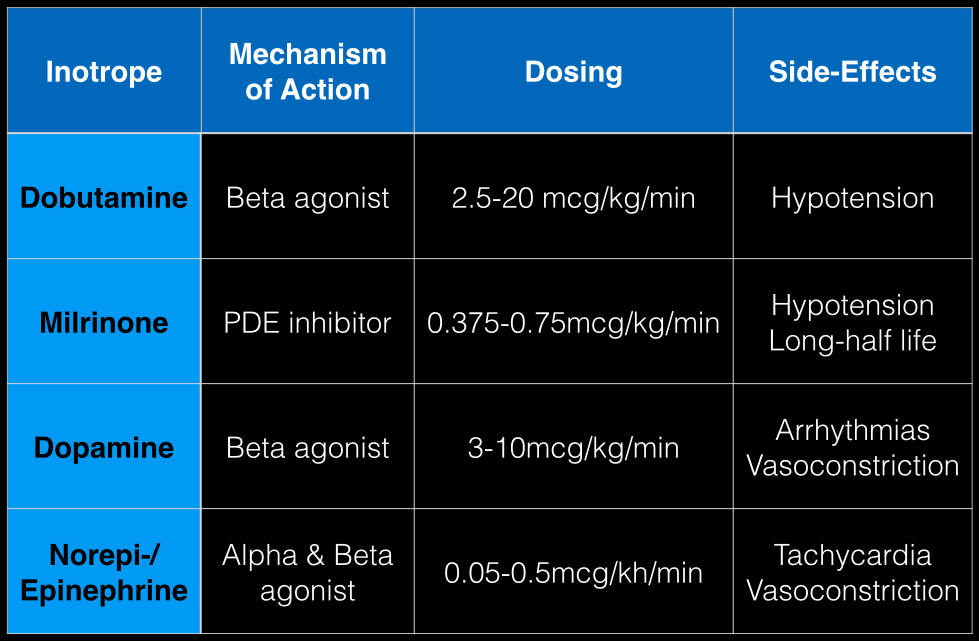
Follow me on Twitter (@criticalcarenow) or Google+ (+criticalcarenow)a
Category: Visual Diagnosis
Posted: 9/28/2014 by Haney Mallemat, MD
(Updated: 10/1/2014)
Click here to contact Haney Mallemat, MD
Person presents with painless vision loss after seeing flashes of light. Ultrasound is below. What's the diagnosis?
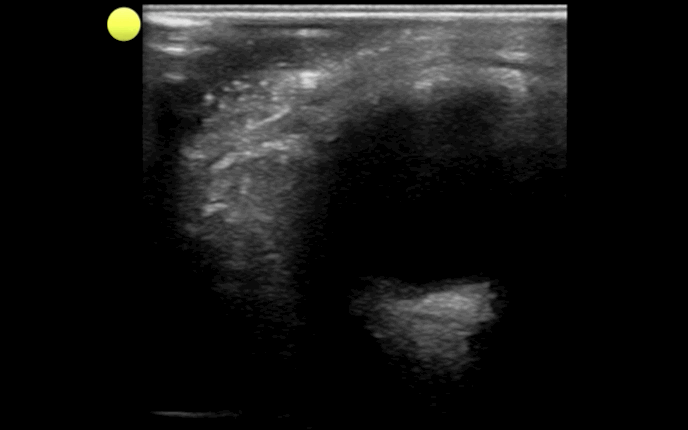
Answer: Vitreous hemorrhage with retinal detachment
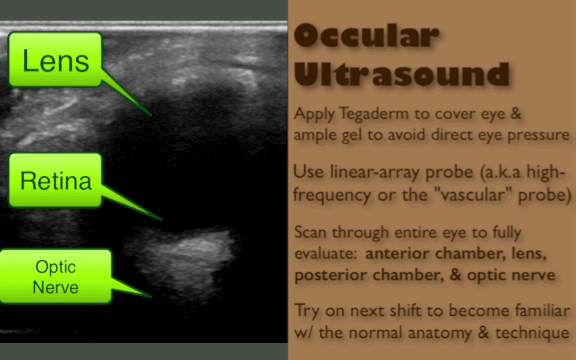
Follow me on Twitter (@criticalcarenow) or Google+ (+criticalcarenow)
Category: Cardiology
Posted: 9/28/2014 by Semhar Tewelde, MD
(Updated: 12/15/2025)
Click here to contact Semhar Tewelde, MD
Ventricular Arrhythmias Originating from the Moderator Band
- Ventricular arrhythmias originating from the moderator band (MB) often have a distinct morphology
- Typically MB arrhythmias have a left bundle branch block pattern, QRS with a late precordial transition (>V4), a rapid down stroke of the QRS in the precordial leads, and a left superior frontal plane axis
- MB arrhythmias are often associated with PVC-induced ventricular fibrillation
- Catheter ablation is quite effective at termination of the arrhythmias and facilitated with intracardiac echocardiography (ICE)
Sadek M, Benhayon D, et al. Idiopathic ventricular arrhythmias originating from the moderator band: Electrocardiographic characteristics and treatment by catheter ablation. Heart Rhythm. Aug 2014
Category: Orthopedics
Keywords: Sciatica, radiculopathy, imaging (PubMed Search)
Posted: 9/19/2014 by Brian Corwell, MD
(Updated: 9/27/2014)
Click here to contact Brian Corwell, MD
Back pain with radiculopathy can be very distressing to a patient and they have heard from their medically savvy neighbor that a MRI is the way to go. Now, armed with this knowledge, they are in your ED with earplugs in hand...
A few minutes of reassurance and education can save in both cost and ED throughput.
In one study researchers performed MRIs on asymtomatic adult patients.
Almost two-thirds (64%) had abnormal discs
Just over half (52%) had bulging discs
Almost a third (31%) had disc protrusions
Further, finding a bulging disc already suggested by your history and physical examination does not change management. The majority of these patients improve with conservative treatment within four to to six weeks.
Restrict ED MRI use for the evaluation of suspected cauda equina, epidural abscess and spinal cord compression.
Category: Pediatrics
Keywords: E. coli, O0157:H7, hematochezia, diarrhea (PubMed Search)
Posted: 9/26/2014 by Mimi Lu, MD
Click here to contact Mimi Lu, MD
There are numerous different causes of pediatric hemorrhagic diarrhea. Consider a pediatric patient with bloody diarrhea as being at risk for developing hemolytic uremic syndrome. Most cases of hemolytic uremic syndrome are caused by O157:H7 strains of E Coli that release Shiga-like toxin from the gut. Systemic release of the toxin causes microvascular thromboses in the renal microvasculature. The characteristic microangiopathic hemolysis results with anemia, thrombocytopenia and peripheral schistocytes seen on laboratory studies, in addition to acute renal failure.
Antibiotics have been controversial in the treatment of pediatric hemorrhagic diarrhea due to concern that they worsen toxin release from children infected with E Coli O157:H7 and thus increase the risk of developing hemolytic uremic syndrome. Numerous previous studies have provided conflicting data regarding the true risk (1). A recent prospective study showed antibiotic treatment increases the risk (2). Most recommendations warn against using antibiotics to treat pediatric hemorrhagic diarrhea unless the patient is septic.
Bottom line: Avoid treating pediatric hemorrhagic diarrhea with antibiotics
References:
1. Systematic review: are antibiotics detrimental or beneficial for the treatment of patients with Escherichia coli O157:H7 infection? Alimentary Pharmacology & Therapeutics. Volume 24, Issue 5, pages 731–742, September 2006
2. Risk factors for the hemolytic uremic syndrome in children infected with Escherichia coli O157:H7: a multivariable analysis. Clin Infect Dis. 2012 Jul;55(1):33-41. doi: 10.1093/cid/cis299. Epub 2012 Mar 19.
Category: Toxicology
Keywords: disulfiram (PubMed Search)
Posted: 9/25/2014 by Fermin Barrueto
(Updated: 12/15/2025)
Click here to contact Fermin Barrueto
When you prescribe certain medications, it may require some further instructions to avoid ethanol or a disulfiram like reaction (nausea, vomiting, flushing) may occur. Keep this short list in your brain:
1) Particular cephalosporins: cefotetan is a the one more likely
2) Nitrofurantoin
3) Sulfonylureas: chlorpropamide and tolbutamide
4) Metronidazole
5) Trimethoprim-sulfamethoxazole
Goldfranks 8th Edition, p1179
Category: Neurology
Keywords: meningitis, clinical exam (PubMed Search)
Posted: 9/25/2014 by Danya Khoujah, MBBS
(Updated: 12/15/2025)
Click here to contact Danya Khoujah, MBBS
Jolt accentuation, the exacerbation of a headache with horizontal rotation of the neck, or shaking of the stretcher in the less cooperative patient, has been promoted for the past few years as the "go-to" test to assess for meningeal irritation in patients with headache. Previous studies have quoted sensitivities as high as 97.1%. (1)
A new prospective study in AJEM challenges this belief by looking at a total of 230 patients with headaches and subsequent LPs. 197 of them had the jolt accentuation test done, which had a sensitivity of only 21% for pleocytosis (defined as greater than or equal to 5 cells/high power field in the 4th CSF tube). Kernig's and Brudzinski's signs both did even more poorly, with a sensitivity of 2% each. (2)
(1) Uchihara T. Jolt accentuation of headache: the most sensitive sign of CSF pleocytosis. Headache. 1991 Mar;31(3):167-71
(2) Nakao JH et al. Jolt accentuation of headache and other clinical signs: poor predictors of meningitis in adults. Am J Emerg Med. 2014 Jan;32(1):24-8
Category: Critical Care
Keywords: massive transfusion, bleeding (PubMed Search)
Posted: 9/23/2014 by Feras Khan, MD
(Updated: 12/15/2025)
Click here to contact Feras Khan, MD
What is a massive transfusion?
When would I use this?
Indications:
-Systolic Blood pressure < 100
-Unable to obtain blood pressure
AND
-Penetrating torso trauma
-Positive FAST
-External blood loss
-Plans to go to the OR
How do I give it?
Does this apply for just traumatic bleeding?
Are there other agents I can use?
What am I trying to do with this protocol?
Murthi SB, Stansbury LG, Dutton RP, et al. TRAnsfusion medicine in trauma patients: an update. Expert Rev Hematol. 2011 Oct;4(5):527-37.
Hess JR, et al. The coagulopathy of trauma: a review of mechanisms. J Trauma. 2008 Oct; 65(4):748-54.
University of Maryland SHOCK Trauma Massive Transfusion Protocol. 2011.
Category: Pediatrics
Keywords: Macklin Phenomenon, asthma, pneumomediastinum (PubMed Search)
Posted: 9/22/2014 by Ashley Strobel, MD
Click here to contact Ashley Strobel, MD
16 yo M with pleuritic right upper chest pain that started today. He is suffering from an asthma exacerbation currently in the setting of URI with cough. He is afebrile, tachycardic to 140-150s, respiratory rate 20, and sats 98% on room air. ECG was performed which incidentally diagnosed this patient WPW and he went for ablation as an outpatient. His chest x-ray showed:
Besides a bad day, what do we call this chest x-ray finding?
Macklin Phenomenon
-asthma exacerbation rupture of the alveoli causing pneumomediastinum
-typically a young man
-most common chief complaint is chest pain
Physical Exam: Hamman’s sign may be present (crackle with heartbeat) or subcutaneous emphysema
Etiology: Esophagus, lungs, or bronchial tree
Rupture of alveoli: asthma exacerbation (bronchial hyper-reactivity/constriction), barotrauma, valsalva maneuvers (lifting, childbirth), deep respiratory maneuvers/Valsalva (strenuous exercise or FVC breathing), drug use (crack cocaine causing bronchial constriction, marijuana), vomiting, blunt thoracic/abdominal trauma, scuba diving with rapid ascent
Aerodigestive tract injuries: bronchoscopy tracheobronchial injuries, laryngeal fx, bronchial fx, tracheal neoplasm, esophageal injuries (Boerhaave syndrome, paripartum, asthma exacerbation, esophageal neoplasm)
Extension from neck: head/neck sx, RPA/PTA, dental abscess/extractions
Extension from RP/chest wall: rupture RP hollow viscus
Management:
-self -limited
-treat underlying condition
-swallow study for all cases following emesis to rule out Boerhaave’s syndrome
-no repeat CXR, advance diet as tolerated, 23 hour observation
-Al-Mufarrei, et al suggest without trauma, pleural effusion, hemodynamic instability, pneumoperitoneum, or severe vomiting, the finding of spontaneous pneumomediastinum (with or without Meckler’s triad of esophageal rupture: vomiting, lower chest pain, and cervical subcutaneous emphysema after overindulgence) usually leads to unnecessary radiologic investigations, dietary restriction, and antibiotic administration
-surgery for decompression
Gray JM and Hanson GC. Mediastinal emphysema: aetiology, diagnosis, and treatment. Thorax. 1966; 21: 325-332.
Al-Mufarrej F, Badar J, Gharagozloo F, Tempesta B, Strother E, Margolis M. Spontaneous pneumomediastinum: diagnostic and therapeutic intervnetions. Journal of Cardiothoracic Surgery. November 2008; 3: 59.
Category: Orthopedics
Keywords: Tendon, Laceration, Repair (PubMed Search)
Posted: 9/19/2014 by Michael Bond, MD
(Updated: 9/20/2014)
Click here to contact Michael Bond, MD
Tendon Lacerations:
A reasonable approach to all tendon lacerations is to loosly reapproximate the wound and splint the hand in the position of function until the patient can be seen by a hand surgeon in the next 1-3 days. These injuries do not require immediate surgical repair, and with the high rate of complications it is probably best to discuss with your hand surgeon before attempting a repair.
Wheeless Textbook of Orthopaedics. http://www.wheelessonline.com/ortho/extensor_tendon_lacerations
Category: Pediatrics
Keywords: cervical spine, pediatrics, NEXUS (PubMed Search)
Posted: 9/19/2014 by Jenny Guyther, MD
(Updated: 12/15/2025)
Click here to contact Jenny Guyther, MD
The NEXUS criteria is widely applied to adults who present with neck pain due to trauma. While this study did include about 2000 pediatric patients, there were not enough young children to draw definitive conclusions. For more information on the evaluation of the cervical spine, see Dr. Rice's pearl from 9/7/12. A 2003 study piloted an algorithm for cervical spine clearance in children < 8 years.
Patients were spine immobilized if: unconscious, abnormal neurological exam, history of transient neurological symptoms, significant mechanism of injury, neck pain, focal neck tenderness or inability to assess based on distracting injury (extremity or facial fractures, open wound, thoracic injuries, or abdominal injuries), physical exam findings of neck trauma, unreliable exam due to substance abuse, significant trauma to the head or face, or inconsolable children.
When the 2 pathways (see attached) were implemented, there was a decrease in time to cervical spine clearance. There were no missed injuries in the study period prior to implementation of the pathway or once it was implemented. There was no significant difference in the amount of xrays, CT scans or MRIs.
Lee S, Sena M, Greenholtz, S, Fledderman M. A Multidisciplinary Approach to the Development of a Cervical Spine Clearance Protocol: Process, Rationale, and Initial Results. Journal of Pediatric Surgery 2003; 38 (3): 358-362.
Category: Toxicology
Keywords: ciguatera, scromboid, tetrodotoxin (PubMed Search)
Posted: 9/18/2014 by Hong Kim, MD
Click here to contact Hong Kim, MD
Food poisoning can occur with many different food groups/items, as well as how the food is prepared, handled or stored.
There are three specific “food poisonings” associated with fish consumption can cause serious toxicity/illness beyond GI symptoms: Ciguatera, Scrombroid, tetrodotoxin (puffer fish)
Ciguatera
Symptoms:
May progress to develop…
Treatment: supportive care and mannitol in presence of severe neurologic symptoms (limited evidence).
Scrombroid
Symptoms:
Tx: H1/H2 blockers and supportive care
Serious reactions: treat like allergic/anaphylactic reaction
Tetrodotoxin
Symptoms:
Treatment: supportive care and intubated if needed.
